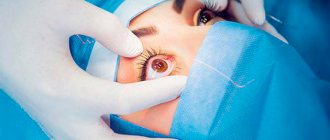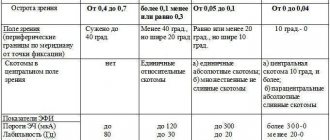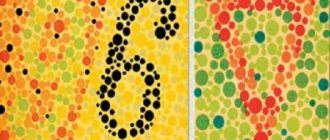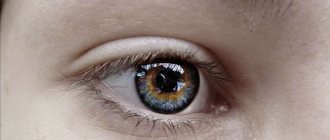Without a driver's license, a person has no right to drive a car; this is punishable by a fine. Before obtaining a license, it is necessary to undergo an examination, a number of doctors will announce their results, and after that it is decided whether the person will receive a license or not.
Particular attention is paid to the visual analyzer. They go to an ophthalmologist to make sure that their eyes are working properly, because with poor vision, the risk of serious road accidents increases.
Passing an examination by an ophthalmologist
The vision requirements for drivers are high. The ability to drive a vehicle alone is not enough. First of all, visual perception influences a positive result in obtaining a license.
A person with poor eyesight is referred to an ophthalmologist before taking a driving school so that he does not waste money on training.
Color blindness test
This testing involves Rabkin's pictures. The patient is seated at a distance of 1 m from the images. Then they show the shapes printed on paper using different colors.
The patient names the depicted figures/numbers. Testing allows you to determine whether a person has deviations in color vision. It consists of 24 images.
Color blindness test
If a patient is diagnosed with “protanopia” (immunity to red) or “deuteranopia” (immunity to green), a driver’s license will not be issued. Violation of red color receptors is the most common case.
If color vision is normal, a diagnosis is made - normal trichromatism. Some people do not distinguish colors at all; they see the world in black and white. This disease is called achromasia.
Testing can also be done at home using a computer. The main thing is not to get close to the monitor; numbers and figures should be viewed from a distance of at least 1 m. Color calibration on the monitor plays an important role, so it is recommended to visit a doctor.
Outlook test
Excellent visual acuity is not enough to obtain a driver's license. When passing a medical commission, they evaluate their horizons. Normally, it is at least 20 degrees; at lower levels, it is prohibited to drive any vehicle.
Its narrowing indicates pathological conditions, including retinal detachment. Assessing your horizons is necessary to reduce the risk of accidents on roads, especially with three-lane markings.
The patient turns to the ophthalmology center to solve this problem through surgery. If 3 months after this the horizon is at least 20 degrees, the ophthalmologist will give permission to obtain a driver's license.
Check with an ophthalmologist to pass a driver's examination
An ophthalmologist at a medical commission checks:
- visual acuity;
- color perception;
- viewing angle;
- the presence of pathologies of the ocular apparatus.
However, some minor deviations are not a reason for refusing to issue a certificate. There are not many people with 100% vision without the slightest changes. If an applicant for a driver's license uses vision-correcting devices, the examination is carried out using them.
Is it possible to see an ophthalmologist with poor vision?
If you have poor vision, it is important to have glasses or contact lenses with you when you are examined by an ophthalmologist. At an appointment with an ophthalmologist, visual perception is checked based on visibility in the means of correcting visual perception, because a person must always wear glasses when driving a car.
It is possible to see an ophthalmologist with poor vision and gain access to a driver’s license if visual perception falls within the standards specified in the law of the Russian Federation.
If your vision is severely impaired, the ophthalmologist will not give the green light to obtain a license.
Steps to pass a medical examination
Passing a medical examination requires obtaining an appropriate certificate. Without it, obtaining a driver's license, as well as studying at a driving school, is impossible. The category of rights received does not matter.
If you are in any doubt about the level of vision required for a driving licence, it is best to contact a qualified optometrist in advance.
After the examination, if deviations from the norm are detected, it is worth resorting to corrective measures as prescribed by a specialist. For the medical examination, it is required that the corrective means used correspond to the visual acuity and other indications, otherwise it will not be possible to obtain a medical certificate for a driver’s license.
If a specialist advised you to take a course of vision stimulation using a special device. It is also worth following the recommendations.
When undergoing a driver's medical examination, it is worth considering that at different times of the day, visual acuity may change, since different factors influence it. On the eve of the medical examination, you should avoid eye strain and relieve them as much as possible, not only physically, but also psychologically.
How to get a license with poor eyesight
This is possible if you memorize the order of letters from the bottom row. This method does not always save, because the ophthalmologist has a patient’s card, and he knows how far a person can see, having a certain acuity of visual perception.
An experienced ophthalmologist cannot be fooled. In addition, the offices have several tables for testing vision - alphabetic and graphic. The doctor has the right to prescribe an additional examination if the information in the medical record and that obtained during the examination differ significantly.
In any case, the doctor will find out what visual acuity the patient actually has if he conducts a series of diagnostic tests. It will not be possible to obtain a license if you have poor vision, which is not within the scope of the law.
Normal vision for obtaining a driver's license
There are medical examinations for drivers, which also check their vision. There are certain indicators that allow a person to be allowed to drive a vehicle. Acceptable vision for different categories has different meanings:
- For categories A and M, subcategories A1 and B1 with motorcycle seating. Visual acuity is less than 0.6 diopters in the better eye and less than 0.2 diopters in the worse visual organ. This category can be obtained if one eye is blind, and the VA in the second is below 0.8.
- For category B. VA must be at least 0.6, the worst organ of vision sees by 0.2 units.
- For category C, CE, D, DE. VA on the best visual organ should be below 0.8, on the worst - below 0.4.
If a person has good vision in one eye, but the other is completely blind, you can get a license. This condition applies to all categories.
If the patient’s visual perception is not of the same quality as required to obtain a license of a certain category, the medical commission will not allow him to obtain a driver’s license.
What type of vision should you not drive?
The norms established by law allow people with poor vision to receive only categories A and B (in common parlance - amateur license), with corresponding subcategories. The path to becoming a driver may be closed for them even with correction.
Myopia or myopia is a disease of young people, which often becomes a cause for concern when passing a medical examination for a driver’s license. The examination for myopia is carried out from a distance of 5 meters using special tables. The procedure is simple: the patient is asked to name letters or other images of a certain size. Visual acuity is judged by how low the readable sign is located in the table.
The criteria that an ophthalmologist uses when examining potential drivers are as follows:
- For those applying for an “amateur” license (category B, B1 and A, A1), it is permissible to demonstrate visual acuity in one eye of 60% of the established norm, in the other at least 20%. The doctor will write this as a fraction of one, “0.6” or “0.2.”
- For category C, vision preservation in the dominant eye is 80%, in the second eye 40%. In the help it looks like 0.8 and 0.4.
- If there is no difference between the eyes, then each should see at least 70% of normal.
Vision is considered one hundred percent if a person can read the 10th line from the top of a paper table, being five meters away from it. If one eye cannot see at all, then the second must have visual acuity of at least 80% of normal for the doctor to diagnose o.
People whose vision is lower than the above parameters will need glasses. The ophthalmologist will not perform vision correction during the medical examination and will not sign the certificate form 083/u-89. You can return to the re-examination after you receive your glasses or contacts.
Thus, poor vision is not an obstacle to driving a car if the identified defects can be corrected with appropriate optics. The driver will be given a note on the certificate stating that he is allowed to drive while wearing glasses.
Colorblindness test
Color blindness or color blindness in the Russian Federation can become an insurmountable obstacle to obtaining a driver's license. The inability to distinguish colors is revealed during the first medical examination, which is necessary for enrollment in a driving school. Experts distinguish different degrees of color blindness, each of which has its own name.
To test vision, special tables are used, where the inscription or drawing is highlighted in color. A person who is unable to distinguish colors sees only a picture with a pattern of different-sized circles. He cannot say what is additionally depicted inside the card.
People with black-and-white vision (diagnosis of achromatopsia) are not issued a license to drive a car.
Checking the breadth of view
A narrowing of the latitude of lateral vision below 20 degrees is a contraindication for issuing a driver’s license. The test is carried out using special equipment. Correction with optical lenses is not possible here.
If the pathology can be reduced by surgery, then a repeat medical examination will be possible no earlier than a month after the operation.
The list of diseases that are an obstacle to obtaining a driver’s license is set out in the Appendix to the Order of the Ministry of Health and Social Development of December 2011 No. 302n.
Contraindications for obtaining a driver's license
Not every person gets a driver's license. There is a list of pathological conditions under which driving a car is prohibited. Article 23.1 “Medical contraindications, medical indications and medical restrictions for driving vehicles” indicates the conditions under which driving is impossible.
It is difficult for patients diagnosed with color blindness to gain access to the car. This disease is called color blindness; the eyes cannot distinguish certain shades. People are unable to distinguish blue from red.
Patients with color blindness will not receive VA, since they will not be able to distinguish colors at traffic lights, they pose a high risk of car accidents. Previously, they were issued licenses only with categories A and B. In 2021, the Russian Federation will completely abolish the issuance of licenses to persons with color blindness.
VU are not issued to patients if 3 months have not passed since the date of surgery on the visual organs. After surgery, it is necessary to undergo a re-examination.
Also, licenses are not issued for violations of the lacrimal sac, persistent changes in the mucous membrane and muscles of the eyelids. In case of glaucoma, a driver's license is not issued at the last stage of severity.
Fines for driving without glasses or contacts
Not all drivers are obedient citizens. Many people ignore the rules and do not wear vision correction devices. The fines provided for by the Legislation of the Russian Federation were not introduced in order to replenish the treasury, but to punish people who are capable of creating an emergency situation on the road.
There is no information in the Traffic Rules about the need to wear glasses if you have poor vision, and there are no direct instructions in the Code of Administrative Offenses for driving without them. However, there is a law “On Road Traffic Safety”, according to which the driver can be fined 5-15 thousand rubles and the car can be towed to an impound lot.
The fine for driving without glasses and lenses is paid with a 50% discount if done within 20 days from the date of the relevant decision. This is indicated in Article 32.2 of the Code of Administrative Offenses of the Russian Federation.
There is nothing in the law about lenses. According to him, people with poor vision should wear glasses. If a person wears lenses, he is not required to take them out and present them to the inspector. It is enough to show a container or other object indicating the presence of CL in the eyes.
An offense occurs if a person does not wear vision correction devices specified on the driver's license. Not only a fine is possible, but also the opening of a court case.
Officially, it is impossible to avoid a fine. The only option is to cheat by saying that there are lenses and you can’t get them due to the lack of a container and hygienic conditions on the road.









